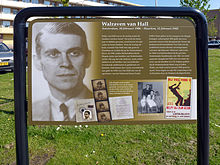Walraven van Hall
Walraven van Hall | |
|---|---|
 Memorial at Gouda | |
| Born | 10 February 1906 |
| Died | 12 February 1945 (aged 39) |
| Nationality | Dutch |
| Other names | "de Olieman", Van Tuyl, Barends and "oom Piet" |
| Occupation | Banker |
Walraven (Wally) van Hall (10 February 1906 – 12 February 1945) was a Dutch banker and resistance leader during the occupation of the Netherlands in World War II.[1][2]
Biography
Born into an influential Dutch family, van Hall initially studied to become an officer in the merchant marine, but after having worked for some years as third mate he was rejected because of his eyesight. Unable to work in the merchant marine, he moved to New York in 1929. His brother, future mayor of Amsterdam Gijs van Hall, who already worked at a bank, helped him get a job with a Wall Street firm. Having thus been introduced to banking, he returned to the Netherlands and became a banker and stockbroker.
After the Germans invaded the Netherlands in May 1940, a fund was established to help families of merchant-sailors (who were stranded abroad when war broke out). Van Hall was asked to help set up the Amsterdam chapter together with his brother Gijs. Because of his banking experience, he was able to provide funding with the help of guarantees by the Dutch government in London. Soon the Germans began taking anti-Jewish and forced labour measures and resistance against these measures increased. Van Hall expanded his fund-raising activities for all kinds of resistance groups and he became known as the banker of the resistance.
One of the ways in which van Hall raised funds for the resistance was the "robbing" of the De Nederlandsche Bank (Dutch National Bank). With the approval of the Dutch government-in-exile, the van Halls managed to obtain as much as 50 million Dutch guilders. According to Nout Wellink, president of the bank in 2010, this figure is comparable to half a billion Euros nowadays. Together with his brother, van Hall falsified banknotes and changed them in the bank for the real notes. With these, paper money was collected. This was done behind the back of Rost van Tonningen, president of the bank and a notorious member of the Dutch Nazi party National Socialist Movement in the Netherlands (NSB).
Another way of collecting money was borrowing from wealthy Dutch people. As a proof of their investments, they got a worthless old stock, but after the war they could get their money back in exchange for the stock paper.
In 1944, Walraven was the leader of the NSF (National Support Fund) and he was the coordinator of the Kern ("nucleus") and the Driehoek ("triangle"), a cooperation of various resistance groups. The NSF supported a variety of resistance groups and underground papers like Trouw, Het Parool and Vrij Nederland.
Walraven had various nicknames in the resistance movement: he was called the Olieman (the oilman) for his abilities to lubricate the friction between resistance groups. Other names were Van Tuyl, Oom Piet (Uncle Pete) and Barends.
His personal courier was Hanneke Ippisch, author of the book Sky. Her job was to find a safe meeting place every Friday for the resistance leaders. On 27 January 1945, the meeting place was given away by a member of the resistance who had been arrested the day before and who wrongly believed the members of the meeting would know he had been arrested and wouldn't attend the meeting. Although the Germans had a vague idea there had to be somebody who coordinated the finances for the resistance, they never found out it was van Hall. In January 1945, nl, a founding member of the Dutch resistance, was betrayed by the Dutch collaborator Johan van Lom. Van Vliet broke under interrogation and as a result the Germans were led to several leading members of the resistance, including van Hall.[3] Van Hall was subsequently executed in Haarlem as revenge for the death of a high-ranking police officer. After the war, he was buried in Overveen on the Erebegraafplaats Bloemendaal (Honorary Cemetery).
Van Hall was posthumously awarded by the Dutch government with the Dutch Cross of Resistance (Verzetskruis). The United States awarded him with the Medal of Freedom with Gold Palm.
In honor of his deeds in the resistance a monument was erected in the fall of 2010 near the Nederlandsche Bank at the Frederiksplein in Amsterdam.
References
- ^ "HALL, Walraven van (1906-1945)". huygens.knaw.nl (in Dutch). Biografisch Woordenboek van Nederland.
- ^ Welgraven, Co. "Walraven van Hall (1906-1945). Bankier van het verzet". historischnieuwsblad.nl (in Dutch). Historisch Nieuwsblad.
- ^ Botje, Harm Ede (30 December 2013). "De verrader en het meisje". Vrij Nederland (in Dutch). Retrieved 8 July 2015.
{{cite news}}: Unknown parameter|coauthors=ignored (|author=suggested) (help)
External links
- Wally van Hall 1906 - 1945. Banker to the Resistance[dead link]
- Website about Wally van Hall (In Dutch)
- Website by historians (Biografisch Woordenboek van Nederland) on van Hall (In Dutch)
